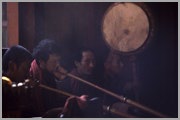
| Morning Ceremony.
After prolonged and heavy snowfall that clogged three successive 5000 meter passes, we
were forced to take an alternate route, causing us to reach "civilization" several days
earlier than anticipated. Our Bhutanese guide immediately arranged for a bus to take us
to several small towns deep in the interior of the country. In the town of Bumthang an
annual religious festival was taking place. We awoke before sunrise one morning to attend
a festival, and were rewarded with this quartet of monks.
|
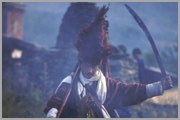
| Dancer.
On another early morning outing, we came across these monks who had built a huge bonfire,
and were performing dances around it.
|
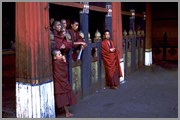
| Young Monks.
In the courtyard of Paro Dzong, we encountered this group of young monks taking a break
from their studies. I particularly enjoyed the sight of the one with the lollipop.
|
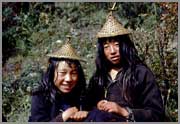
| Laya Girls.
We spent an evening in the town of Laya in the extreme north part of the country. Many of
the women wore these traditional Tibetan "inverted funnel" hats. That evening, the
villagers came to our camp site, built a huge bonfire, passed around some of the local
fire-water, and showed us some of their local dances and performed some songs. A truly
memorable evening. This village was really remote - there were only two trekking groups
going through that year.
|
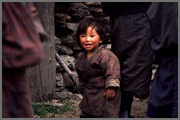
| A Boy and his Chicken.
"I see the boy", you say, "but, where's the chicken?". We stopped for lunch in the
courtyard of a small mountain village, where many of the locals came out to greet us.
Amidst this sea of legs, this young lad was preoccupied chasing a rather speedy chicken.
I must have spent 20 minutes trying to get the two of them in the camera's viewfinder,
but alas the chicken was too fast, and there were just too many other bodies in the way.
So I contented myself with a portrait of the boy (the chicken wasn't that photogenic
anyway). I like his youthful energy.
|
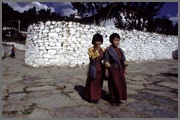
| National Dress.
Nowhere is Bhutan's democratic spirit more readily apparent to the visitor than in the
national dress. Men wear a kho, a long robe tied around the waist by a slim belt.
The folds in the front form a pouch which is used as a pocket, and a cotton or silk vest
with broad white cuffs is worn underneath. At the waist is a small sword for chopping
betel nuts, meat or wood. All men, from the King to the most humble of his subject, wear
this same clothing.
|
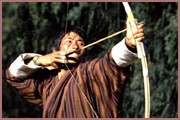
| Archer.
Archery is the national sport and passion of the Bhutanese. Each village has its own
archery range, and it is impossible to imagine any festival taking place without a
high-spirited competition. Many Bhutanese men are skillful archers. The general confidence
in their aim is shown by the number of people who stroll unconcernedly near the targets
during matches. We watched archers shoot arrows the length of a football field and often
hit the target very close to the bullseye. Each particularly good shot was rewarded as the
men standing next to the target would do this little dance and chant.
|
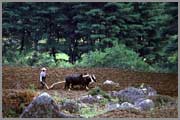
| Ploughman.
While urban settlements have sprung up with the opening of roads, most of Bhutan's people
still live in small rural villages on riverbanks or gently sloping hills. Largely
self-sufficient in food, they grow crops and graze animals for meat, butter, cheese, and
milk. Work is often communal and it is not unusual for a village to have a cooperative to
help farmers sow and harvest their crops.
|








